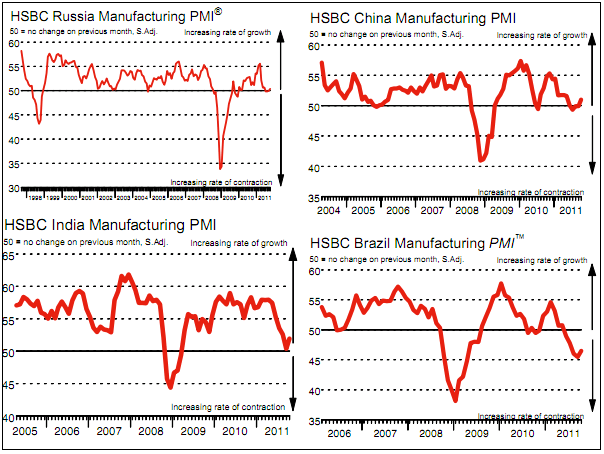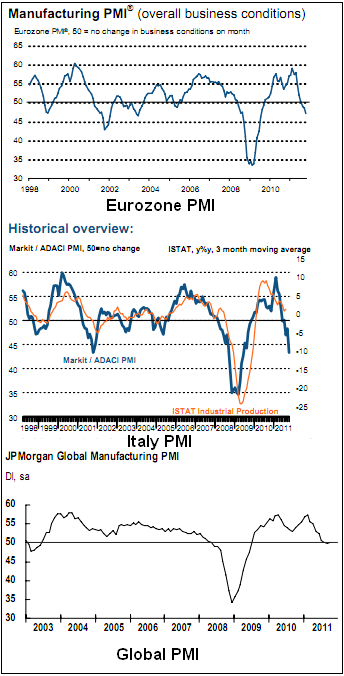There’s some good, some bad and some ugly in this month’s PMI reports. The best news is out of the BRIC regions where we might have seen a trough in the Brazilian downturn and the other regions appear to at least be stabilizing. Russia posted slight growth at 50.4 (up from 50), India posted 52 (up from 50.4), China posted 51 (up from 49.9) and Brazil came in at 46.5 – a deep contraction relative to the others, but up from last month’s 45.5. The Russian report best summarizes the outlook as stable, but fragile:
“Russian manufacturers felt some relief of their concerns in October, the HSBC Russia Manufacturing PMI showed. Both new export orders and total new orders have increased, paving the way for marginally faster output growth. The headline PMI indicator has returned to growth territory after a pause taken in 3Q.
Yet, the improvement in growth momentum appears very modest, and fragile when taking into account the uncertain global economic environment. Scaling down their future output growth expectations, Russian manufacturers reduced headcounts at the fastest rate since 1Q 2010 in October. As a reflection of stretched demand conditions, companies had to accommodate faster growth of input costs, being unable to increase output prices. Charges grew at the slowest rate for more than two years in October.
The bottom line is this: while recession in the Russian manufacturing sector looks remote, stagnation or anaemic growth represents the most likely scenario for the coming months. We have to be prepared for more disappointing industrial production data releases in 4Q than in September.”

Eurozone PMI’s were a bit of a different story and highlight the continuing issues going on in the region. Overall PMI came in at 47.1 with every single country posting a contraction except for Ireland. The most alarming decline was the Italian economy where the PMI came in at 43.3, well below consensus estimates. Analysts looking for Italy’s debt situation to improve any time soon are likely to be disappointed. This bodes very poorly for the outlook. Markit elaborates on the disastrous report from Italy:
“October data signalled a tough start to the fourth quarter for the Italian manufacturing sector. The
headline PMI index posted the largest monthly drop in the series’ history, dipping to its lowest mark since June 2009 and pointing to a marked deterioration in overall business conditions. This was a consequence of a further sharp decrease in new business inflows, as both domestic demand – softened by widespread political and economic uncertainty – and new export orders contracted markedly. Production levels followed suit, falling sharply following September’s brief up-tick. However, indicating a first rise in stocks of finished goods for over two-and-a-half years, latest data suggested that output levels still have some way to fall to match current demand.”
JP Morgan’s global PMI figure came in right at the neutral mark of 50. The USA, of course, posted a slight gain. All in all, a very mixed bag.

Source: Markit, HSBC
Mr. Roche is the Founder and Chief Investment Officer of Discipline Funds.Discipline Funds is a low fee financial advisory firm with a focus on helping people be more disciplined with their finances.
He is also the author of Pragmatic Capitalism: What Every Investor Needs to Understand About Money and Finance, Understanding the Modern Monetary System and Understanding Modern Portfolio Construction.

Comments are closed.